Leadership and Change Management: A Comparative Analysis Report
VerifiedAdded on 2020/07/23
|13
|3621
|45
Report
AI Summary
This report delves into the intricacies of change management within organizations, utilizing a comparative analysis of two UK tourism companies, Thomas Cook and Cosmos Tours. The report begins by comparing the impact of change on the organizational strategies and operations of both companies, highlighting how size and market position influence their approaches. It then evaluates the internal and external drivers of change, such as customer demands, technological advancements, and competitor actions, and assesses their effects on leadership, team dynamics, and individual behavior. Furthermore, the report explores measures to minimize the negative impacts of change on organizational behavior, emphasizing the importance of communication, employee involvement, and strategic planning. The second part of the report focuses on identifying barriers to change and their influence on leadership decision-making. It also examines various leadership approaches to effectively manage organizational changes, including strategies for overcoming resistance and fostering a culture of adaptability. The report concludes by synthesizing the findings and offering recommendations for successful change management practices.
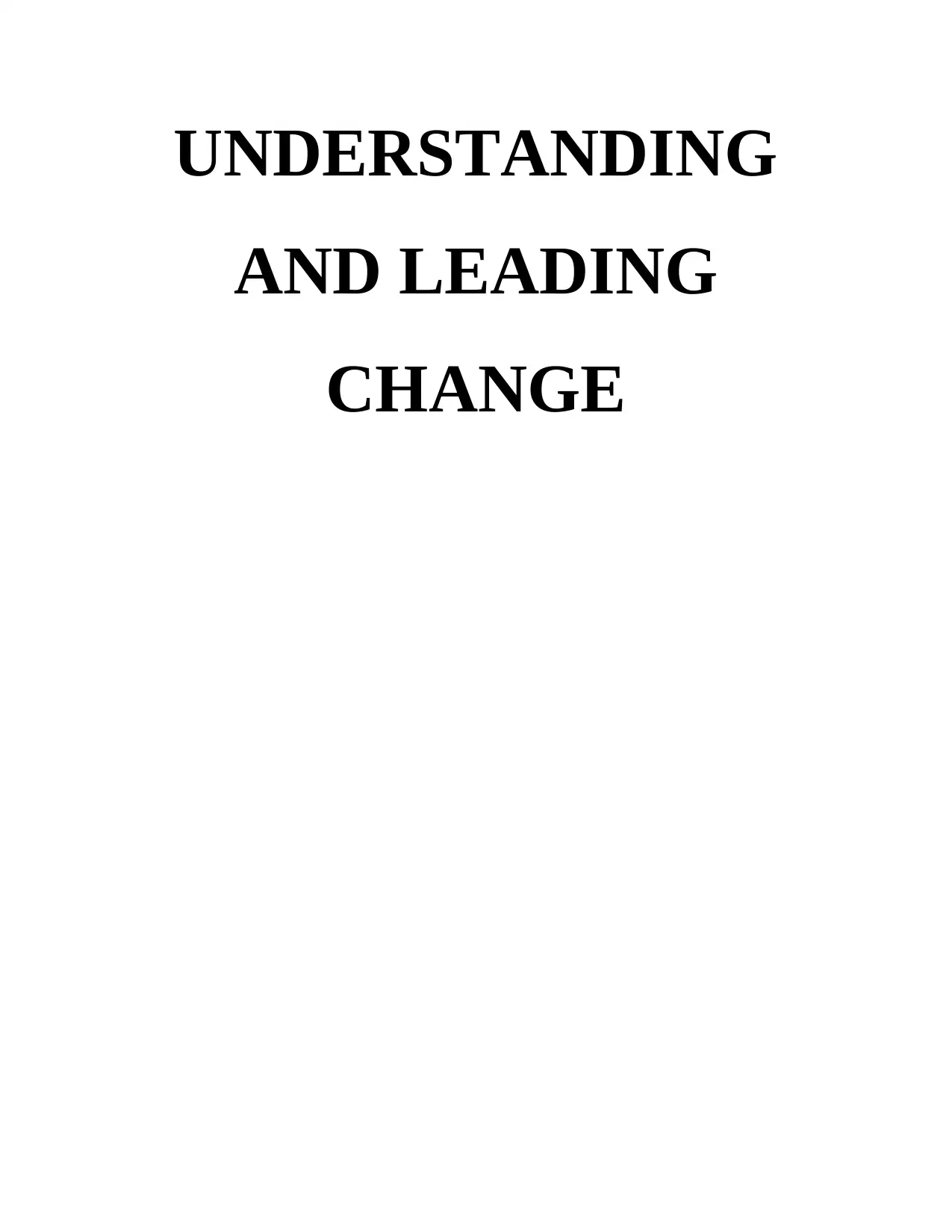
UNDERSTANDING
AND LEADING
CHANGE
AND LEADING
CHANGE
Paraphrase This Document
Need a fresh take? Get an instant paraphrase of this document with our AI Paraphraser
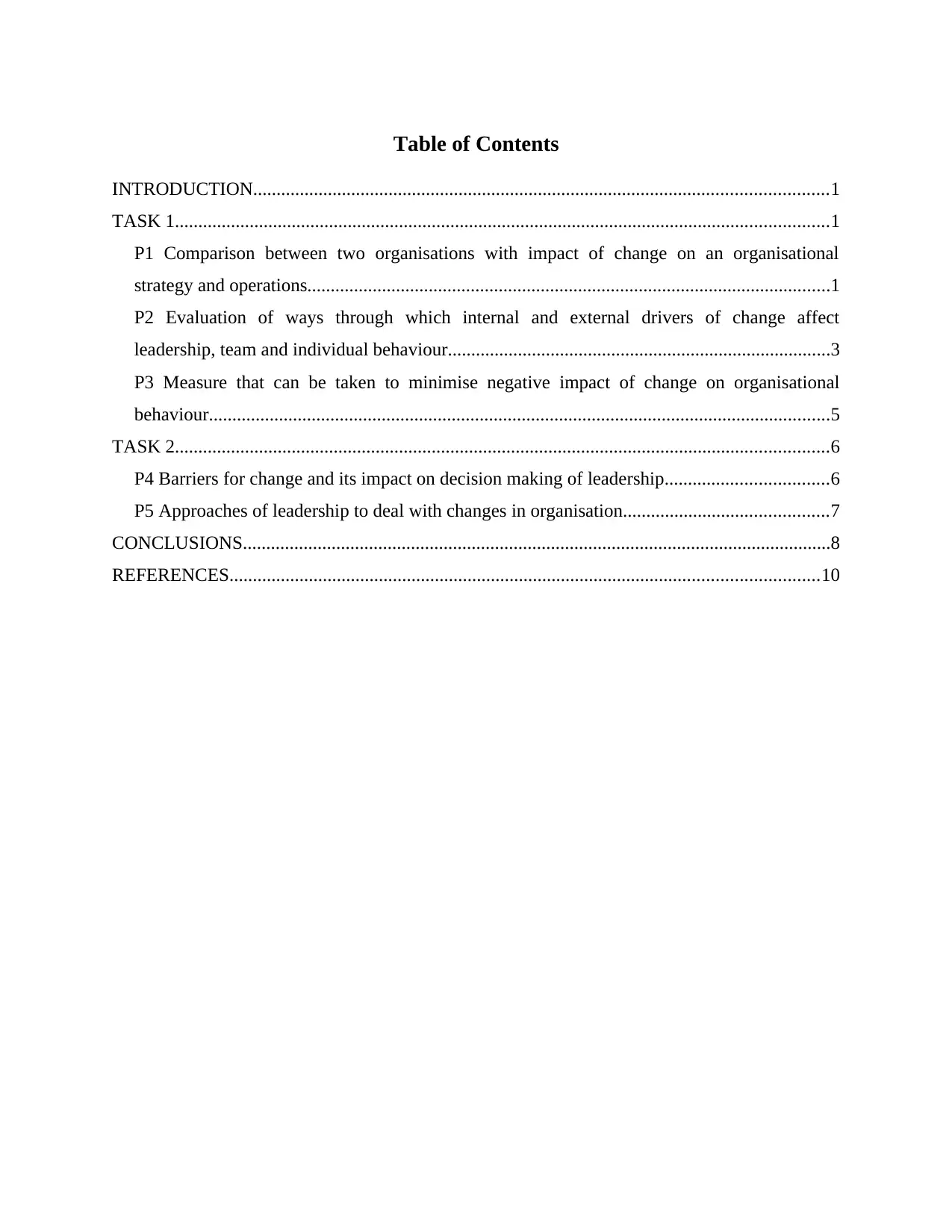
Table of Contents
INTRODUCTION...........................................................................................................................1
TASK 1............................................................................................................................................1
P1 Comparison between two organisations with impact of change on an organisational
strategy and operations................................................................................................................1
P2 Evaluation of ways through which internal and external drivers of change affect
leadership, team and individual behaviour..................................................................................3
P3 Measure that can be taken to minimise negative impact of change on organisational
behaviour.....................................................................................................................................5
TASK 2............................................................................................................................................6
P4 Barriers for change and its impact on decision making of leadership...................................6
P5 Approaches of leadership to deal with changes in organisation............................................7
CONCLUSIONS..............................................................................................................................8
REFERENCES..............................................................................................................................10
INTRODUCTION...........................................................................................................................1
TASK 1............................................................................................................................................1
P1 Comparison between two organisations with impact of change on an organisational
strategy and operations................................................................................................................1
P2 Evaluation of ways through which internal and external drivers of change affect
leadership, team and individual behaviour..................................................................................3
P3 Measure that can be taken to minimise negative impact of change on organisational
behaviour.....................................................................................................................................5
TASK 2............................................................................................................................................6
P4 Barriers for change and its impact on decision making of leadership...................................6
P5 Approaches of leadership to deal with changes in organisation............................................7
CONCLUSIONS..............................................................................................................................8
REFERENCES..............................................................................................................................10
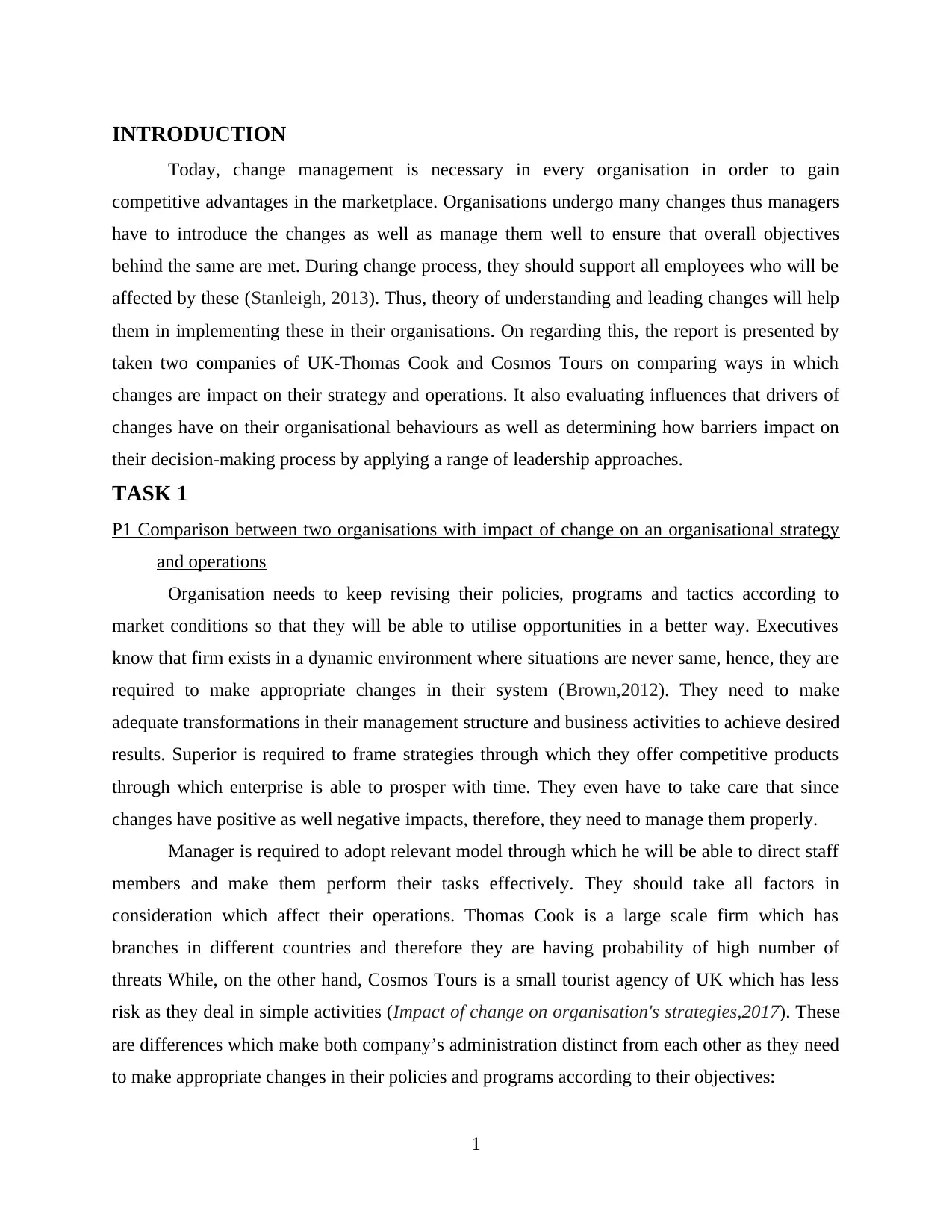
INTRODUCTION
Today, change management is necessary in every organisation in order to gain
competitive advantages in the marketplace. Organisations undergo many changes thus managers
have to introduce the changes as well as manage them well to ensure that overall objectives
behind the same are met. During change process, they should support all employees who will be
affected by these (Stanleigh, 2013). Thus, theory of understanding and leading changes will help
them in implementing these in their organisations. On regarding this, the report is presented by
taken two companies of UK-Thomas Cook and Cosmos Tours on comparing ways in which
changes are impact on their strategy and operations. It also evaluating influences that drivers of
changes have on their organisational behaviours as well as determining how barriers impact on
their decision-making process by applying a range of leadership approaches.
TASK 1
P1 Comparison between two organisations with impact of change on an organisational strategy
and operations
Organisation needs to keep revising their policies, programs and tactics according to
market conditions so that they will be able to utilise opportunities in a better way. Executives
know that firm exists in a dynamic environment where situations are never same, hence, they are
required to make appropriate changes in their system (Brown,2012). They need to make
adequate transformations in their management structure and business activities to achieve desired
results. Superior is required to frame strategies through which they offer competitive products
through which enterprise is able to prosper with time. They even have to take care that since
changes have positive as well negative impacts, therefore, they need to manage them properly.
Manager is required to adopt relevant model through which he will be able to direct staff
members and make them perform their tasks effectively. They should take all factors in
consideration which affect their operations. Thomas Cook is a large scale firm which has
branches in different countries and therefore they are having probability of high number of
threats While, on the other hand, Cosmos Tours is a small tourist agency of UK which has less
risk as they deal in simple activities (Impact of change on organisation's strategies,2017). These
are differences which make both company’s administration distinct from each other as they need
to make appropriate changes in their policies and programs according to their objectives:
1
Today, change management is necessary in every organisation in order to gain
competitive advantages in the marketplace. Organisations undergo many changes thus managers
have to introduce the changes as well as manage them well to ensure that overall objectives
behind the same are met. During change process, they should support all employees who will be
affected by these (Stanleigh, 2013). Thus, theory of understanding and leading changes will help
them in implementing these in their organisations. On regarding this, the report is presented by
taken two companies of UK-Thomas Cook and Cosmos Tours on comparing ways in which
changes are impact on their strategy and operations. It also evaluating influences that drivers of
changes have on their organisational behaviours as well as determining how barriers impact on
their decision-making process by applying a range of leadership approaches.
TASK 1
P1 Comparison between two organisations with impact of change on an organisational strategy
and operations
Organisation needs to keep revising their policies, programs and tactics according to
market conditions so that they will be able to utilise opportunities in a better way. Executives
know that firm exists in a dynamic environment where situations are never same, hence, they are
required to make appropriate changes in their system (Brown,2012). They need to make
adequate transformations in their management structure and business activities to achieve desired
results. Superior is required to frame strategies through which they offer competitive products
through which enterprise is able to prosper with time. They even have to take care that since
changes have positive as well negative impacts, therefore, they need to manage them properly.
Manager is required to adopt relevant model through which he will be able to direct staff
members and make them perform their tasks effectively. They should take all factors in
consideration which affect their operations. Thomas Cook is a large scale firm which has
branches in different countries and therefore they are having probability of high number of
threats While, on the other hand, Cosmos Tours is a small tourist agency of UK which has less
risk as they deal in simple activities (Impact of change on organisation's strategies,2017). These
are differences which make both company’s administration distinct from each other as they need
to make appropriate changes in their policies and programs according to their objectives:
1
⊘ This is a preview!⊘
Do you want full access?
Subscribe today to unlock all pages.

Trusted by 1+ million students worldwide
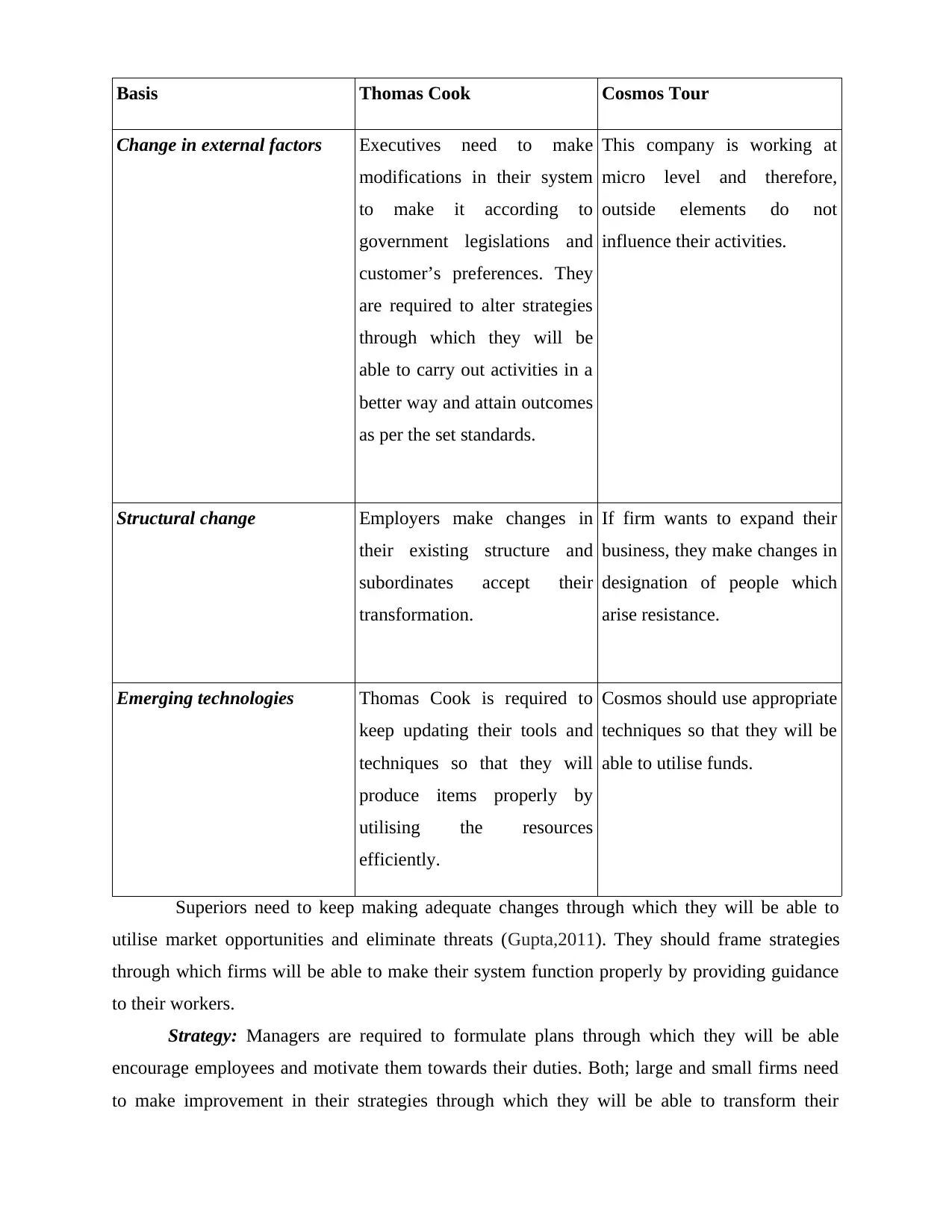
Basis Thomas Cook Cosmos Tour
Change in external factors Executives need to make
modifications in their system
to make it according to
government legislations and
customer’s preferences. They
are required to alter strategies
through which they will be
able to carry out activities in a
better way and attain outcomes
as per the set standards.
This company is working at
micro level and therefore,
outside elements do not
influence their activities.
Structural change Employers make changes in
their existing structure and
subordinates accept their
transformation.
If firm wants to expand their
business, they make changes in
designation of people which
arise resistance.
Emerging technologies Thomas Cook is required to
keep updating their tools and
techniques so that they will
produce items properly by
utilising the resources
efficiently.
Cosmos should use appropriate
techniques so that they will be
able to utilise funds.
Superiors need to keep making adequate changes through which they will be able to
utilise market opportunities and eliminate threats (Gupta,2011). They should frame strategies
through which firms will be able to make their system function properly by providing guidance
to their workers.
Strategy: Managers are required to formulate plans through which they will be able
encourage employees and motivate them towards their duties. Both; large and small firms need
to make improvement in their strategies through which they will be able to transform their
Change in external factors Executives need to make
modifications in their system
to make it according to
government legislations and
customer’s preferences. They
are required to alter strategies
through which they will be
able to carry out activities in a
better way and attain outcomes
as per the set standards.
This company is working at
micro level and therefore,
outside elements do not
influence their activities.
Structural change Employers make changes in
their existing structure and
subordinates accept their
transformation.
If firm wants to expand their
business, they make changes in
designation of people which
arise resistance.
Emerging technologies Thomas Cook is required to
keep updating their tools and
techniques so that they will
produce items properly by
utilising the resources
efficiently.
Cosmos should use appropriate
techniques so that they will be
able to utilise funds.
Superiors need to keep making adequate changes through which they will be able to
utilise market opportunities and eliminate threats (Gupta,2011). They should frame strategies
through which firms will be able to make their system function properly by providing guidance
to their workers.
Strategy: Managers are required to formulate plans through which they will be able
encourage employees and motivate them towards their duties. Both; large and small firms need
to make improvement in their strategies through which they will be able to transform their
Paraphrase This Document
Need a fresh take? Get an instant paraphrase of this document with our AI Paraphraser
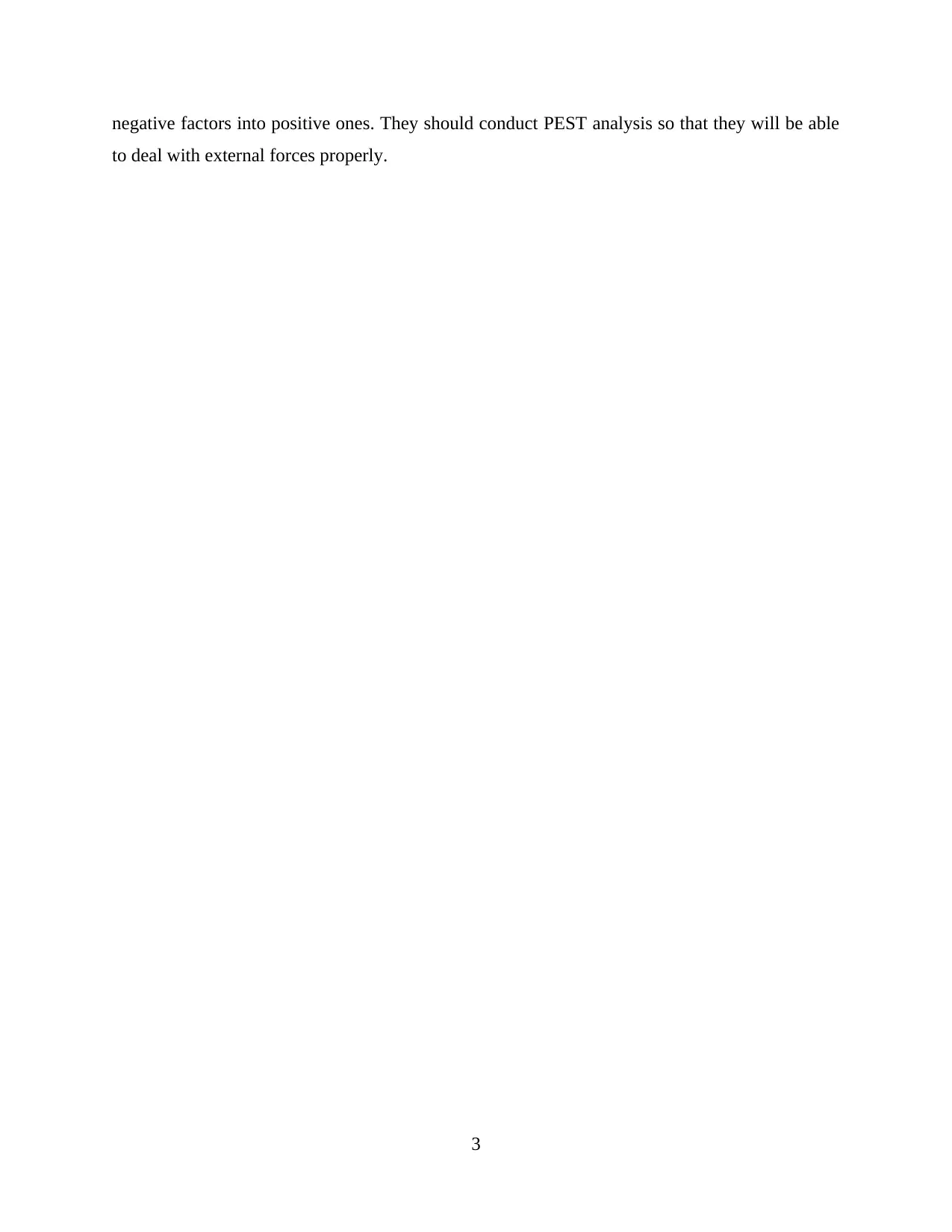
negative factors into positive ones. They should conduct PEST analysis so that they will be able
to deal with external forces properly.
3
to deal with external forces properly.
3
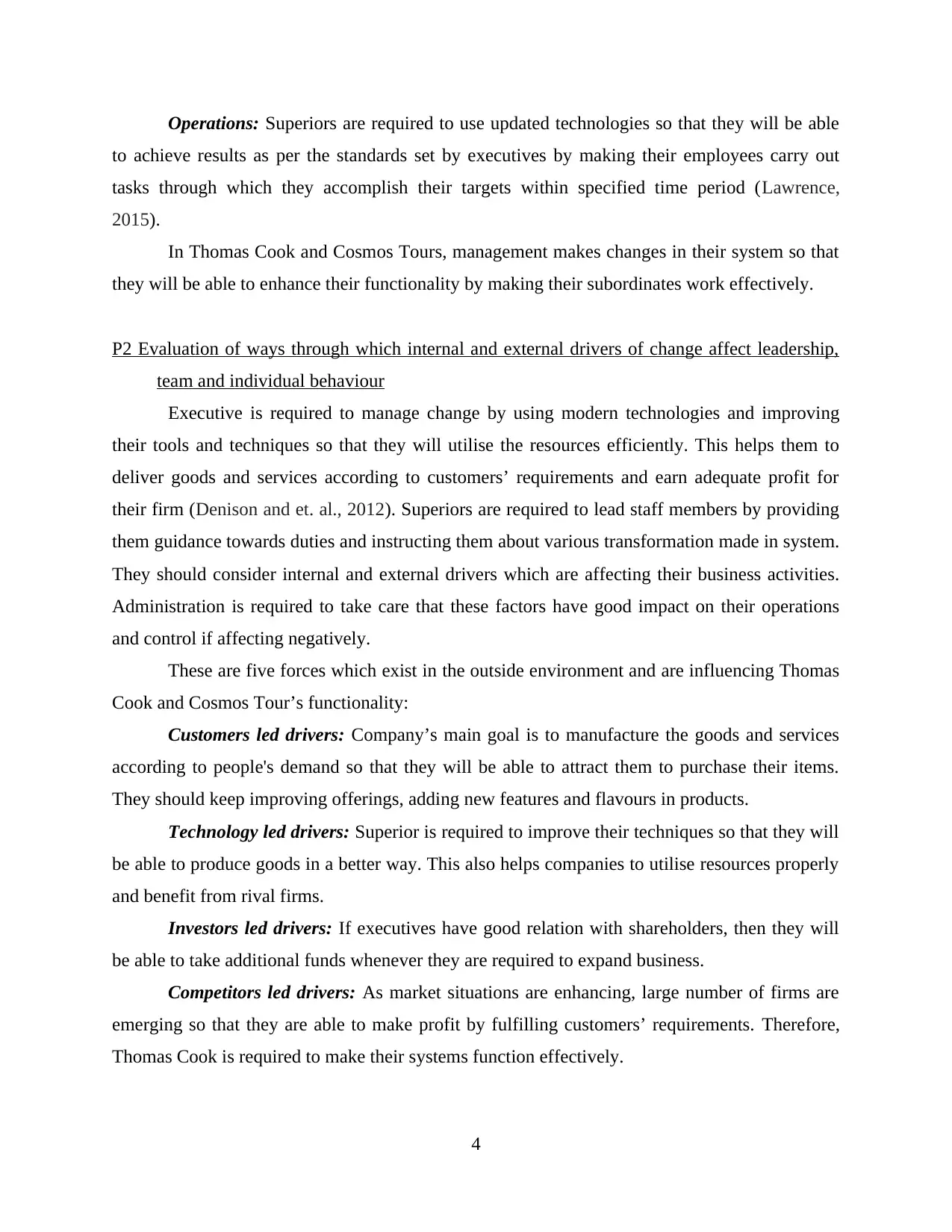
Operations: Superiors are required to use updated technologies so that they will be able
to achieve results as per the standards set by executives by making their employees carry out
tasks through which they accomplish their targets within specified time period (Lawrence,
2015).
In Thomas Cook and Cosmos Tours, management makes changes in their system so that
they will be able to enhance their functionality by making their subordinates work effectively.
P2 Evaluation of ways through which internal and external drivers of change affect leadership,
team and individual behaviour
Executive is required to manage change by using modern technologies and improving
their tools and techniques so that they will utilise the resources efficiently. This helps them to
deliver goods and services according to customers’ requirements and earn adequate profit for
their firm (Denison and et. al., 2012). Superiors are required to lead staff members by providing
them guidance towards duties and instructing them about various transformation made in system.
They should consider internal and external drivers which are affecting their business activities.
Administration is required to take care that these factors have good impact on their operations
and control if affecting negatively.
These are five forces which exist in the outside environment and are influencing Thomas
Cook and Cosmos Tour’s functionality:
Customers led drivers: Company’s main goal is to manufacture the goods and services
according to people's demand so that they will be able to attract them to purchase their items.
They should keep improving offerings, adding new features and flavours in products.
Technology led drivers: Superior is required to improve their techniques so that they will
be able to produce goods in a better way. This also helps companies to utilise resources properly
and benefit from rival firms.
Investors led drivers: If executives have good relation with shareholders, then they will
be able to take additional funds whenever they are required to expand business.
Competitors led drivers: As market situations are enhancing, large number of firms are
emerging so that they are able to make profit by fulfilling customers’ requirements. Therefore,
Thomas Cook is required to make their systems function effectively.
4
to achieve results as per the standards set by executives by making their employees carry out
tasks through which they accomplish their targets within specified time period (Lawrence,
2015).
In Thomas Cook and Cosmos Tours, management makes changes in their system so that
they will be able to enhance their functionality by making their subordinates work effectively.
P2 Evaluation of ways through which internal and external drivers of change affect leadership,
team and individual behaviour
Executive is required to manage change by using modern technologies and improving
their tools and techniques so that they will utilise the resources efficiently. This helps them to
deliver goods and services according to customers’ requirements and earn adequate profit for
their firm (Denison and et. al., 2012). Superiors are required to lead staff members by providing
them guidance towards duties and instructing them about various transformation made in system.
They should consider internal and external drivers which are affecting their business activities.
Administration is required to take care that these factors have good impact on their operations
and control if affecting negatively.
These are five forces which exist in the outside environment and are influencing Thomas
Cook and Cosmos Tour’s functionality:
Customers led drivers: Company’s main goal is to manufacture the goods and services
according to people's demand so that they will be able to attract them to purchase their items.
They should keep improving offerings, adding new features and flavours in products.
Technology led drivers: Superior is required to improve their techniques so that they will
be able to produce goods in a better way. This also helps companies to utilise resources properly
and benefit from rival firms.
Investors led drivers: If executives have good relation with shareholders, then they will
be able to take additional funds whenever they are required to expand business.
Competitors led drivers: As market situations are enhancing, large number of firms are
emerging so that they are able to make profit by fulfilling customers’ requirements. Therefore,
Thomas Cook is required to make their systems function effectively.
4
⊘ This is a preview!⊘
Do you want full access?
Subscribe today to unlock all pages.

Trusted by 1+ million students worldwide
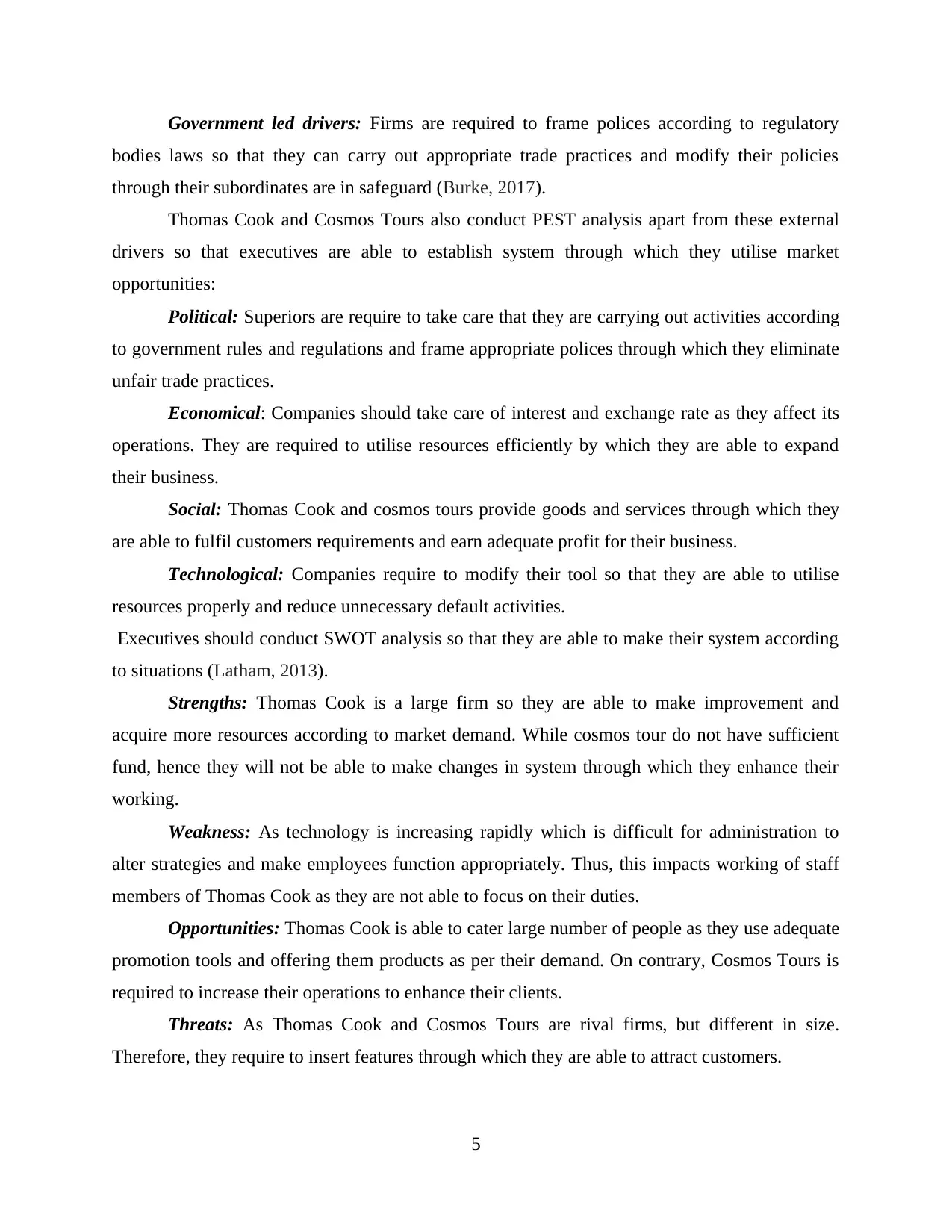
Government led drivers: Firms are required to frame polices according to regulatory
bodies laws so that they can carry out appropriate trade practices and modify their policies
through their subordinates are in safeguard (Burke, 2017).
Thomas Cook and Cosmos Tours also conduct PEST analysis apart from these external
drivers so that executives are able to establish system through which they utilise market
opportunities:
Political: Superiors are require to take care that they are carrying out activities according
to government rules and regulations and frame appropriate polices through which they eliminate
unfair trade practices.
Economical: Companies should take care of interest and exchange rate as they affect its
operations. They are required to utilise resources efficiently by which they are able to expand
their business.
Social: Thomas Cook and cosmos tours provide goods and services through which they
are able to fulfil customers requirements and earn adequate profit for their business.
Technological: Companies require to modify their tool so that they are able to utilise
resources properly and reduce unnecessary default activities.
Executives should conduct SWOT analysis so that they are able to make their system according
to situations (Latham, 2013).
Strengths: Thomas Cook is a large firm so they are able to make improvement and
acquire more resources according to market demand. While cosmos tour do not have sufficient
fund, hence they will not be able to make changes in system through which they enhance their
working.
Weakness: As technology is increasing rapidly which is difficult for administration to
alter strategies and make employees function appropriately. Thus, this impacts working of staff
members of Thomas Cook as they are not able to focus on their duties.
Opportunities: Thomas Cook is able to cater large number of people as they use adequate
promotion tools and offering them products as per their demand. On contrary, Cosmos Tours is
required to increase their operations to enhance their clients.
Threats: As Thomas Cook and Cosmos Tours are rival firms, but different in size.
Therefore, they require to insert features through which they are able to attract customers.
5
bodies laws so that they can carry out appropriate trade practices and modify their policies
through their subordinates are in safeguard (Burke, 2017).
Thomas Cook and Cosmos Tours also conduct PEST analysis apart from these external
drivers so that executives are able to establish system through which they utilise market
opportunities:
Political: Superiors are require to take care that they are carrying out activities according
to government rules and regulations and frame appropriate polices through which they eliminate
unfair trade practices.
Economical: Companies should take care of interest and exchange rate as they affect its
operations. They are required to utilise resources efficiently by which they are able to expand
their business.
Social: Thomas Cook and cosmos tours provide goods and services through which they
are able to fulfil customers requirements and earn adequate profit for their business.
Technological: Companies require to modify their tool so that they are able to utilise
resources properly and reduce unnecessary default activities.
Executives should conduct SWOT analysis so that they are able to make their system according
to situations (Latham, 2013).
Strengths: Thomas Cook is a large firm so they are able to make improvement and
acquire more resources according to market demand. While cosmos tour do not have sufficient
fund, hence they will not be able to make changes in system through which they enhance their
working.
Weakness: As technology is increasing rapidly which is difficult for administration to
alter strategies and make employees function appropriately. Thus, this impacts working of staff
members of Thomas Cook as they are not able to focus on their duties.
Opportunities: Thomas Cook is able to cater large number of people as they use adequate
promotion tools and offering them products as per their demand. On contrary, Cosmos Tours is
required to increase their operations to enhance their clients.
Threats: As Thomas Cook and Cosmos Tours are rival firms, but different in size.
Therefore, they require to insert features through which they are able to attract customers.
5
Paraphrase This Document
Need a fresh take? Get an instant paraphrase of this document with our AI Paraphraser
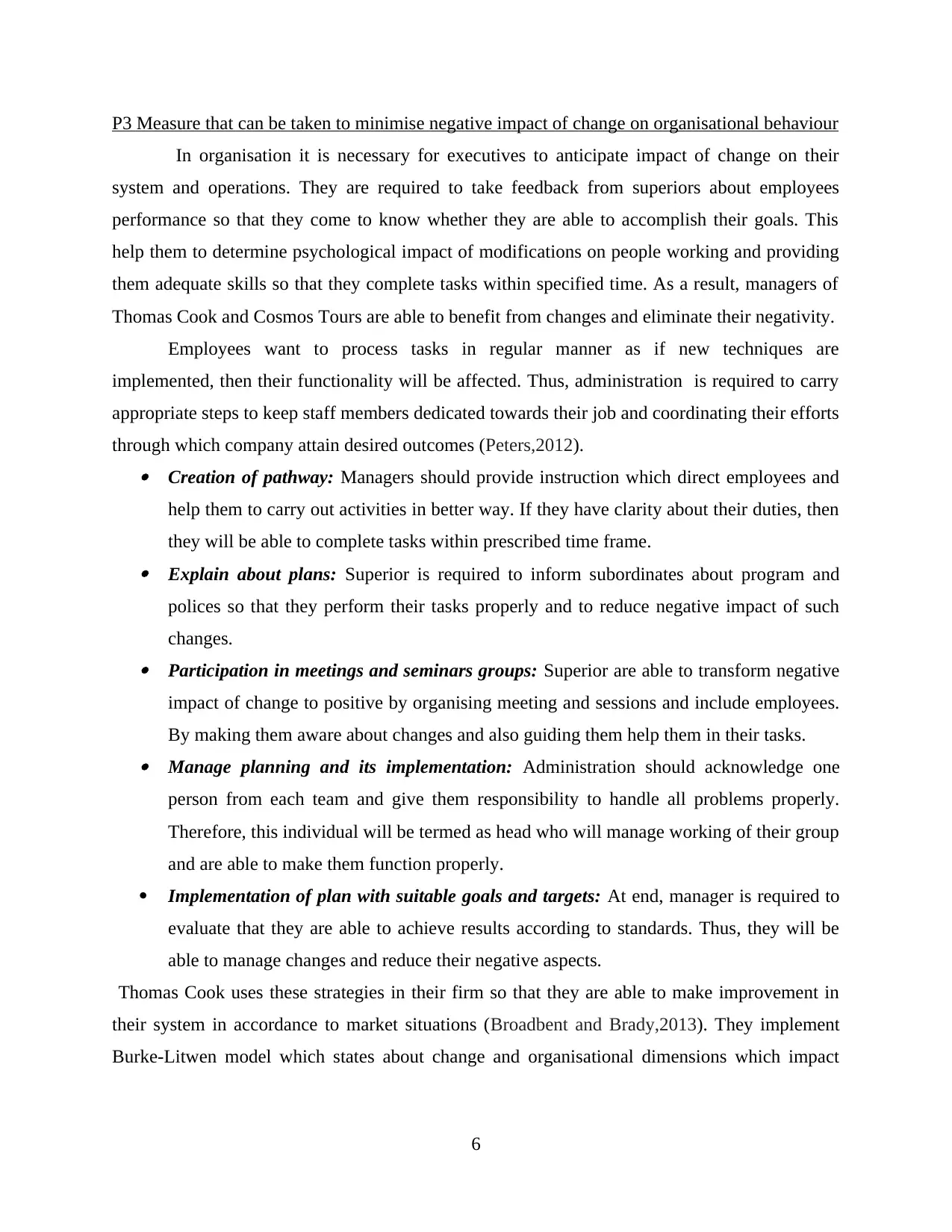
P3 Measure that can be taken to minimise negative impact of change on organisational behaviour
In organisation it is necessary for executives to anticipate impact of change on their
system and operations. They are required to take feedback from superiors about employees
performance so that they come to know whether they are able to accomplish their goals. This
help them to determine psychological impact of modifications on people working and providing
them adequate skills so that they complete tasks within specified time. As a result, managers of
Thomas Cook and Cosmos Tours are able to benefit from changes and eliminate their negativity.
Employees want to process tasks in regular manner as if new techniques are
implemented, then their functionality will be affected. Thus, administration is required to carry
appropriate steps to keep staff members dedicated towards their job and coordinating their efforts
through which company attain desired outcomes (Peters,2012). Creation of pathway: Managers should provide instruction which direct employees and
help them to carry out activities in better way. If they have clarity about their duties, then
they will be able to complete tasks within prescribed time frame. Explain about plans: Superior is required to inform subordinates about program and
polices so that they perform their tasks properly and to reduce negative impact of such
changes. Participation in meetings and seminars groups: Superior are able to transform negative
impact of change to positive by organising meeting and sessions and include employees.
By making them aware about changes and also guiding them help them in their tasks. Manage planning and its implementation: Administration should acknowledge one
person from each team and give them responsibility to handle all problems properly.
Therefore, this individual will be termed as head who will manage working of their group
and are able to make them function properly.
Implementation of plan with suitable goals and targets: At end, manager is required to
evaluate that they are able to achieve results according to standards. Thus, they will be
able to manage changes and reduce their negative aspects.
Thomas Cook uses these strategies in their firm so that they are able to make improvement in
their system in accordance to market situations (Broadbent and Brady,2013). They implement
Burke-Litwen model which states about change and organisational dimensions which impact
6
In organisation it is necessary for executives to anticipate impact of change on their
system and operations. They are required to take feedback from superiors about employees
performance so that they come to know whether they are able to accomplish their goals. This
help them to determine psychological impact of modifications on people working and providing
them adequate skills so that they complete tasks within specified time. As a result, managers of
Thomas Cook and Cosmos Tours are able to benefit from changes and eliminate their negativity.
Employees want to process tasks in regular manner as if new techniques are
implemented, then their functionality will be affected. Thus, administration is required to carry
appropriate steps to keep staff members dedicated towards their job and coordinating their efforts
through which company attain desired outcomes (Peters,2012). Creation of pathway: Managers should provide instruction which direct employees and
help them to carry out activities in better way. If they have clarity about their duties, then
they will be able to complete tasks within prescribed time frame. Explain about plans: Superior is required to inform subordinates about program and
polices so that they perform their tasks properly and to reduce negative impact of such
changes. Participation in meetings and seminars groups: Superior are able to transform negative
impact of change to positive by organising meeting and sessions and include employees.
By making them aware about changes and also guiding them help them in their tasks. Manage planning and its implementation: Administration should acknowledge one
person from each team and give them responsibility to handle all problems properly.
Therefore, this individual will be termed as head who will manage working of their group
and are able to make them function properly.
Implementation of plan with suitable goals and targets: At end, manager is required to
evaluate that they are able to achieve results according to standards. Thus, they will be
able to manage changes and reduce their negative aspects.
Thomas Cook uses these strategies in their firm so that they are able to make improvement in
their system in accordance to market situations (Broadbent and Brady,2013). They implement
Burke-Litwen model which states about change and organisational dimensions which impact
6
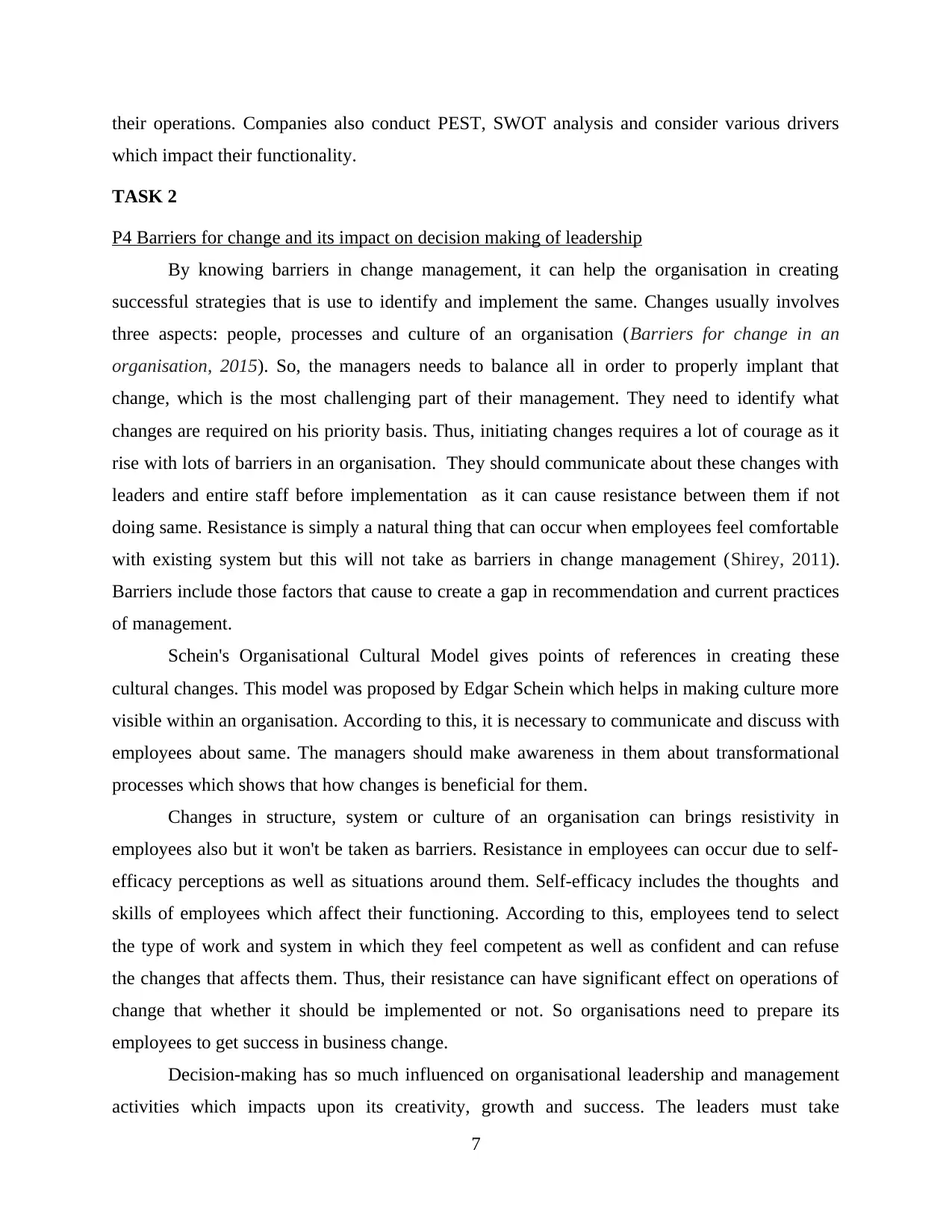
their operations. Companies also conduct PEST, SWOT analysis and consider various drivers
which impact their functionality.
TASK 2
P4 Barriers for change and its impact on decision making of leadership
By knowing barriers in change management, it can help the organisation in creating
successful strategies that is use to identify and implement the same. Changes usually involves
three aspects: people, processes and culture of an organisation (Barriers for change in an
organisation, 2015). So, the managers needs to balance all in order to properly implant that
change, which is the most challenging part of their management. They need to identify what
changes are required on his priority basis. Thus, initiating changes requires a lot of courage as it
rise with lots of barriers in an organisation. They should communicate about these changes with
leaders and entire staff before implementation as it can cause resistance between them if not
doing same. Resistance is simply a natural thing that can occur when employees feel comfortable
with existing system but this will not take as barriers in change management (Shirey, 2011).
Barriers include those factors that cause to create a gap in recommendation and current practices
of management.
Schein's Organisational Cultural Model gives points of references in creating these
cultural changes. This model was proposed by Edgar Schein which helps in making culture more
visible within an organisation. According to this, it is necessary to communicate and discuss with
employees about same. The managers should make awareness in them about transformational
processes which shows that how changes is beneficial for them.
Changes in structure, system or culture of an organisation can brings resistivity in
employees also but it won't be taken as barriers. Resistance in employees can occur due to self-
efficacy perceptions as well as situations around them. Self-efficacy includes the thoughts and
skills of employees which affect their functioning. According to this, employees tend to select
the type of work and system in which they feel competent as well as confident and can refuse
the changes that affects them. Thus, their resistance can have significant effect on operations of
change that whether it should be implemented or not. So organisations need to prepare its
employees to get success in business change.
Decision-making has so much influenced on organisational leadership and management
activities which impacts upon its creativity, growth and success. The leaders must take
7
which impact their functionality.
TASK 2
P4 Barriers for change and its impact on decision making of leadership
By knowing barriers in change management, it can help the organisation in creating
successful strategies that is use to identify and implement the same. Changes usually involves
three aspects: people, processes and culture of an organisation (Barriers for change in an
organisation, 2015). So, the managers needs to balance all in order to properly implant that
change, which is the most challenging part of their management. They need to identify what
changes are required on his priority basis. Thus, initiating changes requires a lot of courage as it
rise with lots of barriers in an organisation. They should communicate about these changes with
leaders and entire staff before implementation as it can cause resistance between them if not
doing same. Resistance is simply a natural thing that can occur when employees feel comfortable
with existing system but this will not take as barriers in change management (Shirey, 2011).
Barriers include those factors that cause to create a gap in recommendation and current practices
of management.
Schein's Organisational Cultural Model gives points of references in creating these
cultural changes. This model was proposed by Edgar Schein which helps in making culture more
visible within an organisation. According to this, it is necessary to communicate and discuss with
employees about same. The managers should make awareness in them about transformational
processes which shows that how changes is beneficial for them.
Changes in structure, system or culture of an organisation can brings resistivity in
employees also but it won't be taken as barriers. Resistance in employees can occur due to self-
efficacy perceptions as well as situations around them. Self-efficacy includes the thoughts and
skills of employees which affect their functioning. According to this, employees tend to select
the type of work and system in which they feel competent as well as confident and can refuse
the changes that affects them. Thus, their resistance can have significant effect on operations of
change that whether it should be implemented or not. So organisations need to prepare its
employees to get success in business change.
Decision-making has so much influenced on organisational leadership and management
activities which impacts upon its creativity, growth and success. The leaders must take
7
⊘ This is a preview!⊘
Do you want full access?
Subscribe today to unlock all pages.

Trusted by 1+ million students worldwide
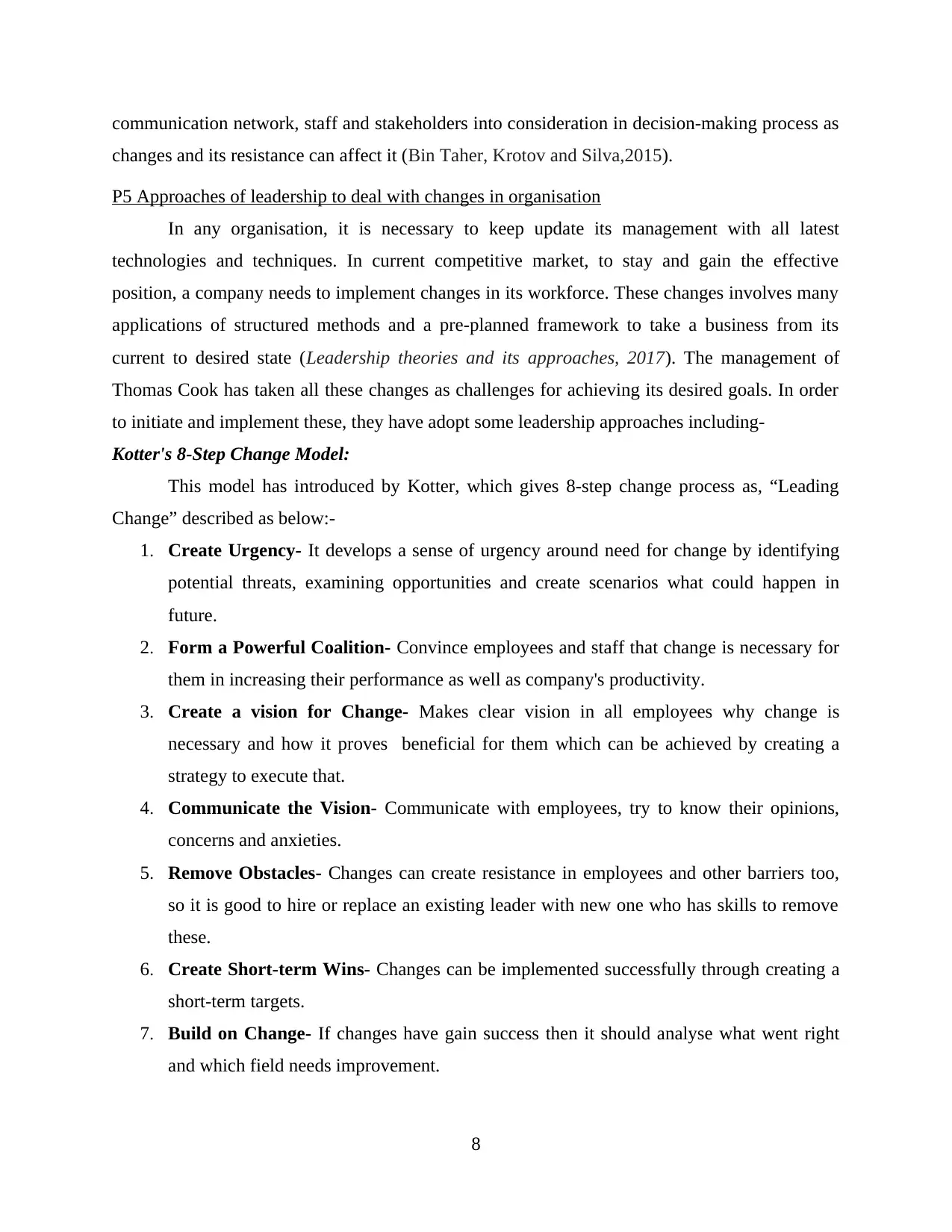
communication network, staff and stakeholders into consideration in decision-making process as
changes and its resistance can affect it (Bin Taher, Krotov and Silva,2015).
P5 Approaches of leadership to deal with changes in organisation
In any organisation, it is necessary to keep update its management with all latest
technologies and techniques. In current competitive market, to stay and gain the effective
position, a company needs to implement changes in its workforce. These changes involves many
applications of structured methods and a pre-planned framework to take a business from its
current to desired state (Leadership theories and its approaches, 2017). The management of
Thomas Cook has taken all these changes as challenges for achieving its desired goals. In order
to initiate and implement these, they have adopt some leadership approaches including-
Kotter's 8-Step Change Model:
This model has introduced by Kotter, which gives 8-step change process as, “Leading
Change” described as below:-
1. Create Urgency- It develops a sense of urgency around need for change by identifying
potential threats, examining opportunities and create scenarios what could happen in
future.
2. Form a Powerful Coalition- Convince employees and staff that change is necessary for
them in increasing their performance as well as company's productivity.
3. Create a vision for Change- Makes clear vision in all employees why change is
necessary and how it proves beneficial for them which can be achieved by creating a
strategy to execute that.
4. Communicate the Vision- Communicate with employees, try to know their opinions,
concerns and anxieties.
5. Remove Obstacles- Changes can create resistance in employees and other barriers too,
so it is good to hire or replace an existing leader with new one who has skills to remove
these.
6. Create Short-term Wins- Changes can be implemented successfully through creating a
short-term targets.
7. Build on Change- If changes have gain success then it should analyse what went right
and which field needs improvement.
8
changes and its resistance can affect it (Bin Taher, Krotov and Silva,2015).
P5 Approaches of leadership to deal with changes in organisation
In any organisation, it is necessary to keep update its management with all latest
technologies and techniques. In current competitive market, to stay and gain the effective
position, a company needs to implement changes in its workforce. These changes involves many
applications of structured methods and a pre-planned framework to take a business from its
current to desired state (Leadership theories and its approaches, 2017). The management of
Thomas Cook has taken all these changes as challenges for achieving its desired goals. In order
to initiate and implement these, they have adopt some leadership approaches including-
Kotter's 8-Step Change Model:
This model has introduced by Kotter, which gives 8-step change process as, “Leading
Change” described as below:-
1. Create Urgency- It develops a sense of urgency around need for change by identifying
potential threats, examining opportunities and create scenarios what could happen in
future.
2. Form a Powerful Coalition- Convince employees and staff that change is necessary for
them in increasing their performance as well as company's productivity.
3. Create a vision for Change- Makes clear vision in all employees why change is
necessary and how it proves beneficial for them which can be achieved by creating a
strategy to execute that.
4. Communicate the Vision- Communicate with employees, try to know their opinions,
concerns and anxieties.
5. Remove Obstacles- Changes can create resistance in employees and other barriers too,
so it is good to hire or replace an existing leader with new one who has skills to remove
these.
6. Create Short-term Wins- Changes can be implemented successfully through creating a
short-term targets.
7. Build on Change- If changes have gain success then it should analyse what went right
and which field needs improvement.
8
Paraphrase This Document
Need a fresh take? Get an instant paraphrase of this document with our AI Paraphraser
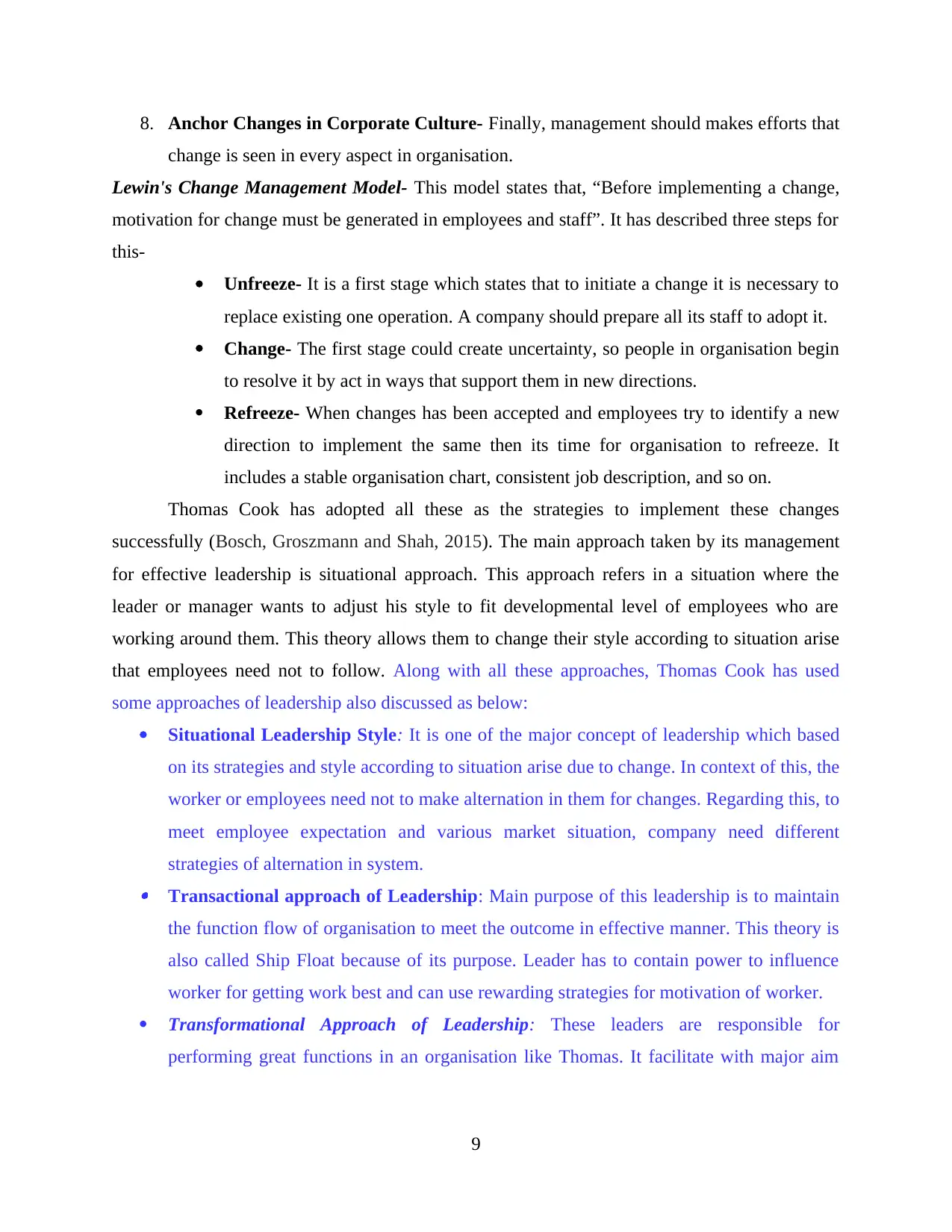
8. Anchor Changes in Corporate Culture- Finally, management should makes efforts that
change is seen in every aspect in organisation.
Lewin's Change Management Model- This model states that, “Before implementing a change,
motivation for change must be generated in employees and staff”. It has described three steps for
this-
Unfreeze- It is a first stage which states that to initiate a change it is necessary to
replace existing one operation. A company should prepare all its staff to adopt it.
Change- The first stage could create uncertainty, so people in organisation begin
to resolve it by act in ways that support them in new directions.
Refreeze- When changes has been accepted and employees try to identify a new
direction to implement the same then its time for organisation to refreeze. It
includes a stable organisation chart, consistent job description, and so on.
Thomas Cook has adopted all these as the strategies to implement these changes
successfully (Bosch, Groszmann and Shah, 2015). The main approach taken by its management
for effective leadership is situational approach. This approach refers in a situation where the
leader or manager wants to adjust his style to fit developmental level of employees who are
working around them. This theory allows them to change their style according to situation arise
that employees need not to follow. Along with all these approaches, Thomas Cook has used
some approaches of leadership also discussed as below:
Situational Leadership Style: It is one of the major concept of leadership which based
on its strategies and style according to situation arise due to change. In context of this, the
worker or employees need not to make alternation in them for changes. Regarding this, to
meet employee expectation and various market situation, company need different
strategies of alternation in system. Transactional approach of Leadership: Main purpose of this leadership is to maintain
the function flow of organisation to meet the outcome in effective manner. This theory is
also called Ship Float because of its purpose. Leader has to contain power to influence
worker for getting work best and can use rewarding strategies for motivation of worker.
Transformational Approach of Leadership: These leaders are responsible for
performing great functions in an organisation like Thomas. It facilitate with major aim
9
change is seen in every aspect in organisation.
Lewin's Change Management Model- This model states that, “Before implementing a change,
motivation for change must be generated in employees and staff”. It has described three steps for
this-
Unfreeze- It is a first stage which states that to initiate a change it is necessary to
replace existing one operation. A company should prepare all its staff to adopt it.
Change- The first stage could create uncertainty, so people in organisation begin
to resolve it by act in ways that support them in new directions.
Refreeze- When changes has been accepted and employees try to identify a new
direction to implement the same then its time for organisation to refreeze. It
includes a stable organisation chart, consistent job description, and so on.
Thomas Cook has adopted all these as the strategies to implement these changes
successfully (Bosch, Groszmann and Shah, 2015). The main approach taken by its management
for effective leadership is situational approach. This approach refers in a situation where the
leader or manager wants to adjust his style to fit developmental level of employees who are
working around them. This theory allows them to change their style according to situation arise
that employees need not to follow. Along with all these approaches, Thomas Cook has used
some approaches of leadership also discussed as below:
Situational Leadership Style: It is one of the major concept of leadership which based
on its strategies and style according to situation arise due to change. In context of this, the
worker or employees need not to make alternation in them for changes. Regarding this, to
meet employee expectation and various market situation, company need different
strategies of alternation in system. Transactional approach of Leadership: Main purpose of this leadership is to maintain
the function flow of organisation to meet the outcome in effective manner. This theory is
also called Ship Float because of its purpose. Leader has to contain power to influence
worker for getting work best and can use rewarding strategies for motivation of worker.
Transformational Approach of Leadership: These leaders are responsible for
performing great functions in an organisation like Thomas. It facilitate with major aim
9
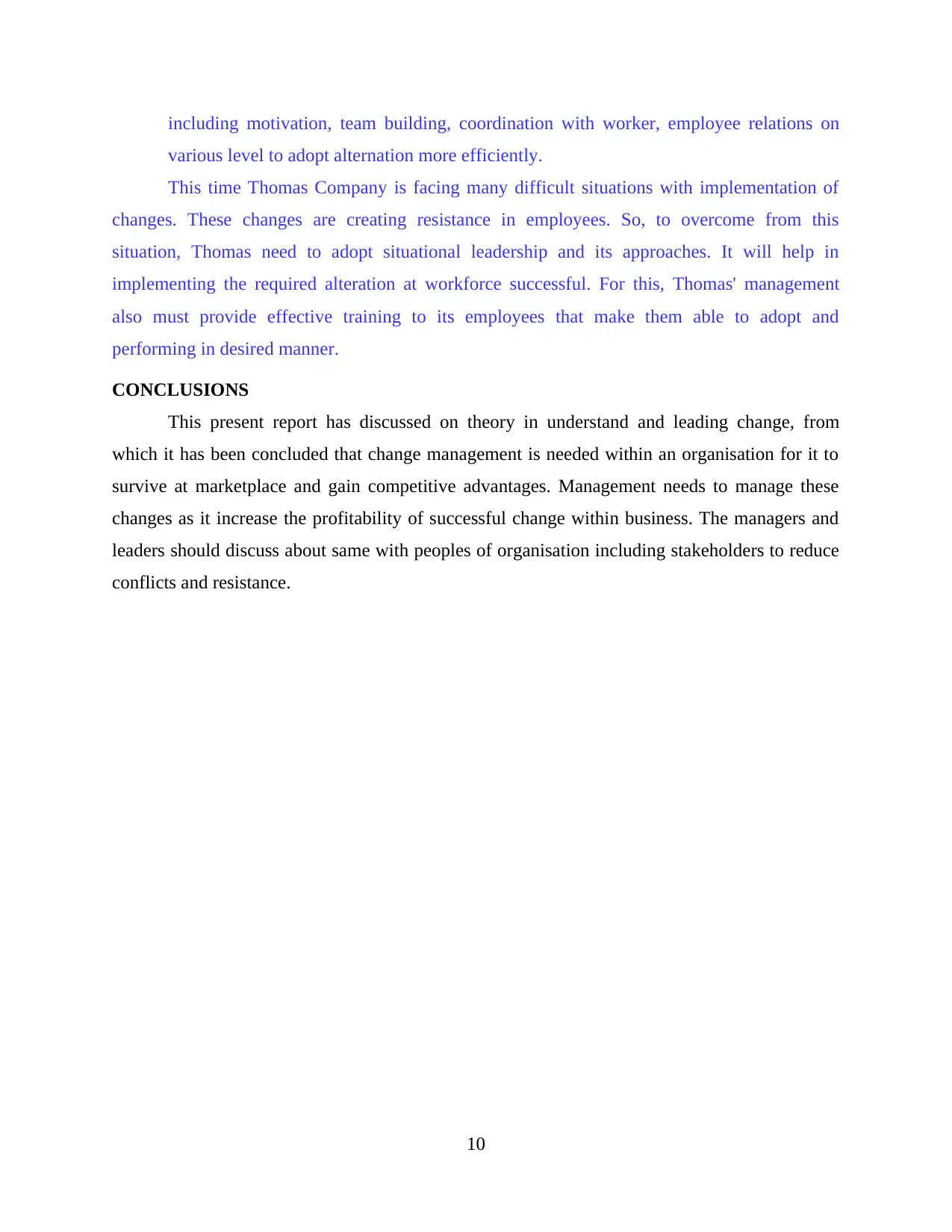
including motivation, team building, coordination with worker, employee relations on
various level to adopt alternation more efficiently.
This time Thomas Company is facing many difficult situations with implementation of
changes. These changes are creating resistance in employees. So, to overcome from this
situation, Thomas need to adopt situational leadership and its approaches. It will help in
implementing the required alteration at workforce successful. For this, Thomas' management
also must provide effective training to its employees that make them able to adopt and
performing in desired manner.
CONCLUSIONS
This present report has discussed on theory in understand and leading change, from
which it has been concluded that change management is needed within an organisation for it to
survive at marketplace and gain competitive advantages. Management needs to manage these
changes as it increase the profitability of successful change within business. The managers and
leaders should discuss about same with peoples of organisation including stakeholders to reduce
conflicts and resistance.
10
various level to adopt alternation more efficiently.
This time Thomas Company is facing many difficult situations with implementation of
changes. These changes are creating resistance in employees. So, to overcome from this
situation, Thomas need to adopt situational leadership and its approaches. It will help in
implementing the required alteration at workforce successful. For this, Thomas' management
also must provide effective training to its employees that make them able to adopt and
performing in desired manner.
CONCLUSIONS
This present report has discussed on theory in understand and leading change, from
which it has been concluded that change management is needed within an organisation for it to
survive at marketplace and gain competitive advantages. Management needs to manage these
changes as it increase the profitability of successful change within business. The managers and
leaders should discuss about same with peoples of organisation including stakeholders to reduce
conflicts and resistance.
10
⊘ This is a preview!⊘
Do you want full access?
Subscribe today to unlock all pages.

Trusted by 1+ million students worldwide
1 out of 13
Related Documents
Your All-in-One AI-Powered Toolkit for Academic Success.
+13062052269
info@desklib.com
Available 24*7 on WhatsApp / Email
![[object Object]](/_next/static/media/star-bottom.7253800d.svg)
Unlock your academic potential
Copyright © 2020–2025 A2Z Services. All Rights Reserved. Developed and managed by ZUCOL.





